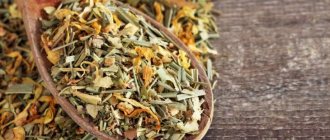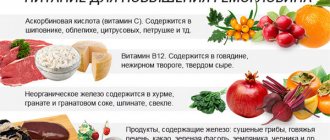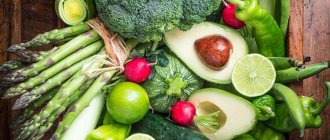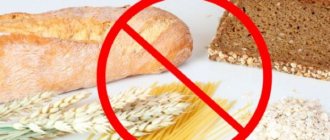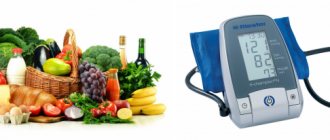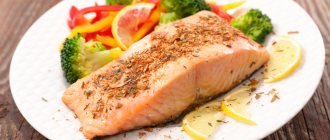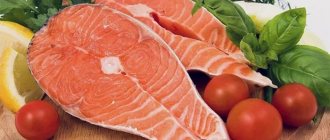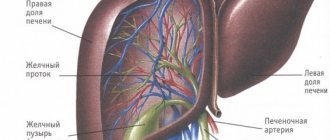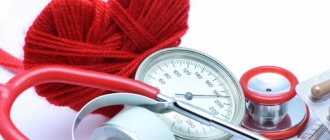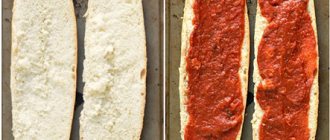Increased hemoglobin is a rather dangerous condition, which in 90% of cases indicates disruptions in the metabolic processes occurring in the body.
This may also mean that tissues and organs experience oxygen starvation, and increased hemoglobin is the body’s protective reaction to a decrease in the amount of micronutrients received.
In any case, according to research , it is possible, in most cases, to lower hemoglobin levels in men and women with the help of a specialized diet. What products best reduce it? And which ones, on the contrary, should not be consumed?
When should hemoglobin be reduced?
In most cases, an increase in hemoglobin levels in adults is complemented by an increase in blood viscosity due to impaired water-salt metabolism. And thick blood leads to an increased risk of blood clots and plaques, and coagulation also increases. All this can be supplemented:
- hypertension (increased blood pressure to a critical level);
- thrombosis (if the blood flow slows down to the point where the blood literally coagulates in some vessels);
- heart attack (if thrombosis affects the heart muscle or the blood vessels that supply it);
- stroke (if thrombosis affects the circulatory system of the brain);
- atherosclerosis (when cholesterol plaques form on the walls of blood vessels, thereby impeding normal blood flow).
At the same time, an increase in hemoglobin may indicate pathologies in metabolic processes when the body receives insufficient amounts of oxygen and other micronutrients.
In some cases, elevated hemoglobin is normal. This happens, for example, among residents of mountainous regions, where the oxygen content in the air is significantly lower.
Also, hemoglobin and red blood cells naturally increase in smokers, since they inhale fumes while smoking. It, in turn, creates inseparable compounds with hemoglobin, thereby deactivating the molecule. In these cases, the hemoglobin level should not be reduced, since the body will experience constant oxygen starvation.
Hemoglobin also often increases in the summer or during regular physical activity, when the body actively loses water and minerals (along with sweat). But normalizing hemoglobin concentration in this case is quite simple - you need to drink as much water as possible (in summer - from 3 liters or more).
What is the norm for hemoglobin
As is already known, the protein is found in red blood cells and is responsible for the transport of oxygen in the body.
To maintain a normal level of health, eliminate fatigue, malaise and other characteristic signs of low hemoglobin, it is recommended to regularly take a blood test to determine protein.
The hemoglobin level is different for everyone, depending on age, gender and physiological characteristics of the body. So, for men this figure is 125-160 g/l, for women 115-140 g/l. In newborn babies, the protein level is in the range of 140-195 g/l; for children one year of age, hemoglobin is 110 g/l. And at school age, the blood protein level is at least 150 g/l.
In women, during pregnancy, hemoglobin drops and this is considered normal. At this time its value is about 110 g/l.
As a rule, a low rate is associated with iron deficiency anemia, which occurs in most people, regardless of age and gender.
General nutrition rules
With elevated hemoglobin, nutritionists recommend following the following tips and recommendations:
- Consume foods and dishes rich in calcium. This element reduces the bioavailability of iron. That is, it slows down its absorption. Namely, iron is the main component of hemoglobin and it is with its help that oxygen and carbon dioxide are transported to/from the lungs.
- Eliminate foods rich in vitamins B12 and B9 from your diet. This will also help reduce the bioavailability of iron and slow down the processes of generating new hemoglobin molecules.
- Eliminate iron-rich foods from your diet. These include apples, greens, beef, pork, meat by-products (liver, lungs, heart), fish. Preference should be given to porridge (with the exception of buckwheat), dairy products, and pasta. The diet for each patient must be prepared individually by a nutritionist.
If we are talking about infants, then breast milk helps them normalize hemoglobin. If artificial feeding (formulas) is used, then you should consult a pediatrician about this - he will recommend formulas that contain a minimum of iron and B vitamins.
Top foods that increase hemoglobin in the blood
Heme iron, from animal products, should account for 15-20% of the diet. Its bioavailability is 30%. This is a high indicator and shows how much iron the body will actually receive from the total amount of iron in the product.
| Sources of heme iron | |
| The product's name | Iron content per 100g |
| Beef meat | 3.6 mg |
| Mutton | 3.1 mg |
| Pork | 1.8 mg |
| Chicken | 1.6 mg |
| Turkey | 1.4 mg |
| Chicken liver | 17.5 mg |
| Pork liver | 20.2 mg |
| Beef liver | 6 mg |
| Oysters | 6.2 mg |
| Tuna | 1 mg |
| Herring | 1 mg |
| Mussels | 3.2 mg |
| Shrimps | 1.8 mg |
| Black caviar | 2.4 mg |
| Chicken egg | 2.5 mg |
| Quail egg | 3.2 mg |
| Chicken egg yolk | 6.7 mg |
The share of non-heme iron, from plant products. should account for 75-80% of the diet. Its bioavailability is only 10%.
| Iron content in plant foods | |
| The product's name | Iron content per 100g |
| Pistachios | 60 mg |
| Spinach | 13.51 mg |
| Lentils | 11.8 mg |
| Peas | 6.8 - 9.4 mg |
| Buckwheat | 8.3 mg |
| Barley grits | 7.4 mg |
| Chickpeas | 6.2 mg |
| Oatmeal | 5.5 mg |
| Wheat | 5.4 mg |
| Peanut | 5 mg |
| bitter chocolate | 4.4 mg |
| Dogwood | 4.1 mg |
| Cashew | 3.8 mg |
| Corn | 3.7 mg |
| Pine nuts | 3 mg |
| Pearl barley | 2.5 mg |
| Beet root vegetable | 1.4 mg |
| Cauliflower | 1.4 mg |
| Carrot | 0.7 mg |
| Potato | 0.9 mg |
| Pumpkin | 0.4 mg |
| Broccoli | 0.73 mg |
| Tomato | 0.9 mg |
| White cabbage | 0.6 mg |
| Turnip | 0.9 mg |
| Spirulina | 28.5 mg |
What should be excluded from the diet?
For greater effectiveness, when following a diet, be sure to exclude from the diet foods that cannot be eaten with increased hemoglobin:
- Fat meat. Particularly “dangerous” are beef, pork, as well as meat by-products (liver, lungs, heart, kidneys, and so on). Meat is rich in iron, as well as B-group vitamins (therefore, iron from such products is easily absorbed).
- Pomegranate and pomegranate juice. Pomegranate increases hemoglobin and blood pressure. For hypotension, it is extremely useful to include in the diet, but with increased blood viscosity, it should be completely excluded.
- Fatty fish. Rich in omega-3 acids, which accelerate most intercellular metabolic processes. Their use should be minimized. You can also include other seafood here, including oysters, shrimp, red and black sparkle, and seaweed.
- Chicken eggs. More precisely, it is the yolks (but the whites – slightly, but still reduce hemoglobin). It is also better to exclude quail from the diet.
- Spices. Turmeric especially strongly increases hemoglobin (it contains not only iron and herbs (parsley, dill, basil), but also B-group vitamins). It is better to temporarily stop using them altogether.
- Cherries and sweet cherries. These berries raise hemoglobin levels no worse than pomegranate and pomegranate juice.
Reasons for decreased hemoglobin levels
The main reasons for a decrease in hemoglobin levels in the blood in men are:
- reduction in the amount of iron entering the body;
- disturbances in the absorption and transport of iron throughout the body;
- a decrease in the number of red blood cells as a result of a violation of their production by the bone marrow or a shortening of life due to various circumstances.
In this case, most often a decrease in hemoglobin is due to iron deficiency in the body. The fact is that the absorption of this microelement from food is limited. Even with proper nutrition, no more than 1-1.5 mg can be absorbed per day, and if there are errors in the diet, the amount of iron entering the body cannot cover the need for it. In such cases, iron depots in the form of ferritin are used to maintain normal life functions. But its reserves are limited, and therefore, when they are depleted, the intensity of bone marrow erythropoiesis decreases. As a result, the number of red blood cells, as well as the level of hemoglobin, decrease, which indicates the development of anemia and is accompanied by the appearance of characteristic symptoms.
Thus, the causes of low hemoglobin in men can be:
- malnutrition;
- insufficient consumption of foods that are sources of iron:
- adherence to a vegetarian diet;
- diseases of the gastrointestinal tract;
- severe bleeding during injuries, operations, including hidden ones (observed with peptic ulcers of the stomach and duodenum, kidney pathologies, pulmonary siderosis, etc.);
- haemorrhoids;
- malignant tumors;
- chronic intoxication;
- vasculitis;
- systemic scleroderma;
- systemic lupus erythematosus;
- helminthiasis;
- cystic fibrosis;
- rheumatoid arthritis, etc.
Statistics show that men are more likely than women to have gastrointestinal diseases caused by Helicobacter pillory, which leads to impaired absorption of iron in the intestines and a decrease in hemoglobin.
Other recommendations
Doctors with elevated hemoglobin also recommend:
- Minimize physical activity. This will help normalize the water-salt balance, reduce blood pressure and blood viscosity.
- Drink as much water as possible. And most importantly - without gas, since the carbon dioxide contained in such water slightly increases the bioavailability of iron (due to stimulation of the gastrointestinal mucosa).
- Refusal of multivitamin complexes. It is especially important to avoid taking B vitamins.
Foods that improve iron absorption
- Vitamin C Rich Foods
It traps non-heme iron and stores it in a form that is easier for your body to absorb.
Foods high in vitamin C include citrus fruits, dark green leafy vegetables, bell peppers, melons and strawberries.
In one study, taking 100 mg of vitamin C with meals increased iron absorption by 67%.
We recommend
“The importance of nutrition for the body: how to plan meals during the day” Read more
Therefore, drinking citrus juice or eating other vitamin C-rich foods while eating foods high in iron can increase your body's absorption.
In vegetarian and vegan diets, iron absorption can be optimized by including vegetables containing vitamin C with meals.
- Products with vitamin A and beta-carotene
Vitamin A plays an important role in maintaining healthy vision, bone growth and your immune system.
Beta carotene
is a red-orange pigment found in plants and fruits. It can be converted into vitamin A.
Good food sources of beta-carotene and vitamin A include carrots, sweet potatoes, spinach, kale, zucchini, red peppers, cantaloupe, apricots, oranges and peaches.
One study of 100 people fed a cereal diet found that the presence of vitamin A increased iron absorption by up to 200% for rice, 80% for wheat and 140% for corn.
Study
: Vitamin A and beta-carotene can improve nonheme iron absorption from rice, wheat and corn by humans
- Meat, fish and poultry
Meat, fish and poultry not only contain highly absorbable heme iron, but can also stimulate the absorption of the non-heme form.
Several studies have reported that adding beef, chicken, or fish to cereal-based meals resulted in an approximately 2- to 3-fold increase in non-heme iron absorption.
Study
: Meat protein fractions enhance nonheme iron absorption in humans
Based on the results of the study, it was found that 1 gram of meat, fish or poultry has a enhancing effect similar to that of 1 mg of vitamin C.
- Folic acid
This is a B vitamin that your body uses to make heme, the part of red blood cells that contains hemoglobin. Without enough folic acid, your red blood cells cannot mature. This can lead to folic acid deficiency anemia and decreased hemoglobin levels.
You can add foods rich in folic acid to your diet
:
- beef
- spinach
- black Eyed Peas
- avocado
- salad
- rice
- beans
- peanut
Thus, you can improve the absorption of iron from food by eating foods high in vitamin C, vitamin A or beta-carotene, folic acid. Eating meat, fish or poultry with other foods may also help.
